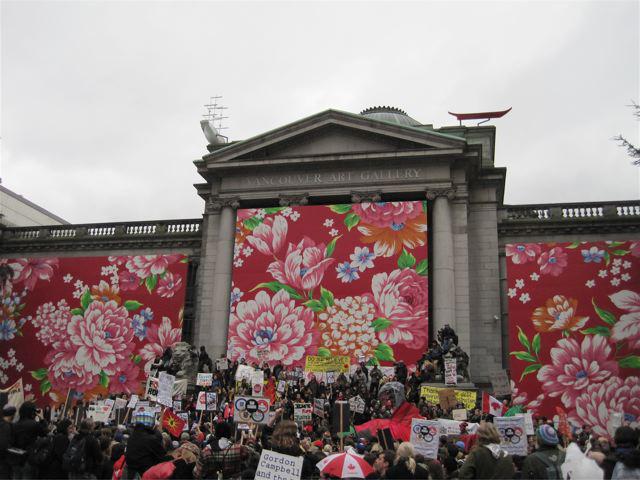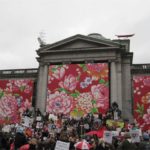For this art lover, marching and chanting “This is what democracy looks like” and “Homes not games” is the ideal way to train muscles for a jam-packed schedule of art gigs, many sponsored by the Vancouver 2010 Cultural Olympiad, which has its stamp all over local galleries, artist-run centres and public spaces.
Olympics host VANOC has handed out $20 million in funding for the Cultural Olympiad, but participation means partaking in the artistic equivalent of drug screening: signing a muzzle clause that restricts content and—horror of horrors—forbids on-site smoking and drinking! Conspicuously absent from the protest are banners, floats and bodies decrying arts funding cuts. Yet many of the debuting shows grapple with themes of collusion, censorship, alienation and rebellion, particularly for artists and stakeholders living and working in one of Canada’s most poverty-stricken postal codes, the Downtown Eastside, where many Olympiad-funded exhibits are opening.
I’ve never seen the Downtown Eastside so scrubbed and shiny, with new garbage cans and yellow-jacketed security guards on every corner. The ’hood is lively with gallery-hoppers and provocative, flickering art projections, most notably what appears to be a blazing building, the installation Fire With Fire by Montreal-based artist Isabelle Hayeur. The installation explores the mobilizing nature of disaster turning to collective complacency, in this case accentuated as acclimated passers-by stroll or trudge past the building, reputing, invalidating and making routine the daily human suffering that has become all too commonplace here.
At nearby Access, Calgary-based artist Jason de Haan’s show “Life After Doomsday” seeks to accompany us through the cataclysm, offering us his own clammy hand. Six clusters of crystals and gems with positive healing properties surround a sound system emitting eerie, body-invading vibrations that become surprisingly soothing and synchronistic. Accompanying the piece is a take-home emergency-prep kit including a booklet drawn from mid-century nuclear survival manuals and bright yellow beer coasters that the artist has scattered around local bars. “The project is about trying to understand my own compulsions and also collective compulsions, to prepare, to be ready,” says de Haan. “But it’s also about a longing to know where you’re actually situated in the world, not to be lost. It’s inquisitive of what’s going on in this city right now, of values and belief systems. But not in a cynical way.”
The music of Joy Division and a grittier spirit of subversive rebellion permeates Grace Gallery’s temporary space. Ronan Boyle’s Smithrite is a collaborative work involving the city’s most notable street artists—The Dark, Office Supplies Incorporated, Black Peter and weakhand—who have each been provided a screen-print of a dumpster upon which they’ve inscribed tags, stencils and posters.
“The Cultural Olympiad is a masquerade meant to dupe the public while arts funding is slashed. There’s no way I’d participate,” says weakhand, whose airbrush-on-paper images seek to engage and service the citizenry, particularly marginalized and poverty-stricken residents more so than rarified, insulated art institutions. “Postering is my way of fighting back at callous bureaucrats, greedy politicians and the big nasty corporate party laying waste to our city.” Let the art games begin.
Danielle Egan is a Vancouver-based freelance journalist with an interest in art, technology and bioscience. She is a contributing editor for Vancouver Magazine and The Tyee and has written for many publications including New Scientist,the Globe & Mail, the San Francisco Chronicle, Seed, Alternet, This Magazine, Jane, Adbusters and Salon. She also writes fiction and has published short stories in Taddle Creek, Vancouver Review, Maisonneuve and Kiss Machine.










